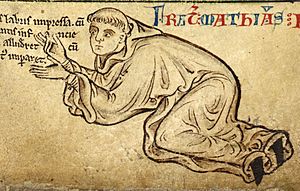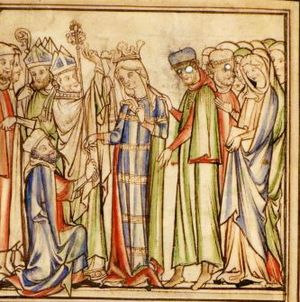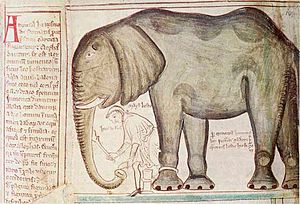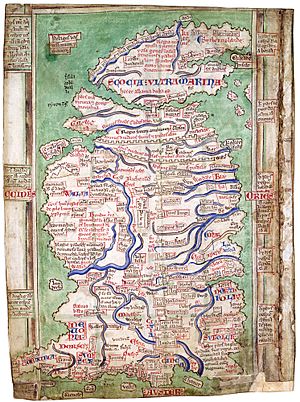Matthew Paris facts for kids
Quick facts for kids
Matthew Paris
|
|
|---|---|

Self-portrait of Matthew Paris from the original manuscript of his Historia Anglorum (London, British Library, MS Royal 14.C.VII, folio 6r
|
|
| Born | c. 1200 possibly Hildersham, Cambridgeshire, England
|
| Died | 1259 (aged c. 59) St. Albans, Hertfordshire, England
|
| Nationality | English |
| Occupation | Historian Author Cartographer Painter |
|
Notable work
|
Chronica Majora Flores Historiarum |
Matthew Paris, also known as Matthew of Paris (Latin: Matthæus Parisiensis, lit. 'Matthew the Parisian'; c. 1200 – 1259), was an English Benedictine monk. He was a talented historian, writer, artist, and mapmaker. Matthew Paris lived and worked at St Albans Abbey in Hertfordshire, England.
He wrote many history books, and he even copied and drew pictures in them himself. He often used drawings with light watercolor colors, called "tinted drawings." Some of his works were in Latin, and others were in French.
His book, the Chronica Majora, is a very famous work from the Middle Ages. It's a key source for understanding Europe in the mid-13th century. Matthew Paris included his own strong opinions in his writing. He also used important sources like letters, official records, and talks with people who saw events happen. These people included King Henry III and King Haakon IV of Norway.
Modern historians know that Matthew Paris had his own opinions. He sometimes praised Emperor Frederick II and criticized the Pope. He also sometimes spoke against the power of the Church and the King. However, in another book, Historia Anglorum, he described Frederick II as a "tyrant" who did "disgraceful crimes."
Contents
Matthew Paris's Life and Work

Even though his name sounds French, Matthew Paris was born in England. Some historians believe his family was from Hildersham, Cambridgeshire. He might have studied in Paris when he was young, after going to St Albans School.
We know from his own writings that he became a monk at St Albans Abbey in 1217. People guess he was around 17 years old when he joined, which helps estimate his birth year. He seemed comfortable with important people like nobles and even kings. This might mean he came from a well-known family.
Matthew Paris spent most of his life at St Albans Abbey. In 1248, he traveled to Norway. He carried a message from King Louis IX to King Haakon IV. He got along so well with the Norwegian king that he was asked to help improve the Benedictine Nidarholm Abbey there.
Writing History at St Albans

Besides his trip to Norway, Matthew Paris spent his time writing history. The monks of St Albans were already famous for this. He took over from Roger of Wendover, who was the abbey's main historian. Roger died in 1236.
Matthew Paris updated Roger's work, a history called Flores Historiarum, which covered events up to 1235. Matthew then added new information from 1236 until his own death in 1259. This updated work is known as the Chronica Majora. It was very useful in his time and is still used by historians today.
While the Chronica Majora is his most famous work now, it wasn't always. Matthew Paris also made two shorter versions of his Chronica. One was called Historia Anglorum, and the other was also named Flores Historiarum, like Roger of Wendover's book. This second Flores was copied many times after his death. Within 250 years, over 20 copies were made.
Matthew Paris was also known for his amazing drawings and maps. These were often in the margins of his books, but sometimes they took up whole pages.
Lending Books to Nobles
Matthew Paris's notes show that he lent his books to important families. For example, he wrote:
- "If you please you can keep this book till Easter."
- "G, please send to the Lady Countess of Arundel, Isabel, that she is to send you the book about St Thomas the Martyr and St Edward which I copied and illustrated, and which the Lady Countess of Cornwall may keep until Whitsuntide."
He also seemed to help noblewomen with their own book projects. He might have advised them on what pictures to include. Lending his illustrated books for weeks or months explains why he made several different versions of his history.
Matthew Paris's Manuscripts

Many of Matthew Paris's books, besides his Chronica, contain different texts. They often start with many introductory pages, including full-page drawings. Some books are incomplete today.
Matthew Paris gave his books to his monastery. After the Dissolution, these books were collected by people who loved old books. Many of his manuscripts are now in the British Library.
Here are some of his important works:
- Chronica Majora: This is his main history book. It covers history from the creation of the world up to 1253. The first part is based on Roger of Wendover's work. After 1235, the content is Matthew Paris's own writing. It has about 100 drawings in the margins, some maps, and full-page drawings of kings.
- Flores Historiarum: This is a shorter version of the Chronica. Part of it is in Paris's own handwriting. It was made for Westminster Abbey.
- Historia Anglorum: This book covers English history from 1070 to 1253. It's a shorter version of the Chronica. It also includes the last part of his Chronica Majora, from 1254 to 1259. This book has tinted drawings of the kings of England.
- Abbreviatio chronicorum (or Historia minor): Another shorter history, mostly from 1067 to 1253. It has 33 drawings of English kings. It also contains one of his most detailed maps of Great Britain.
- Liber Additamentorum: This book contains maps, illustrated lives of saints, and copies of original documents like letters. It has his famous drawing of an elephant.
- Life of St Alban: This book tells the story of St Alban in French verse. It has 54 beautiful drawings.
- Life of King Edward the Confessor: This book is about King Edward the Confessor. It's believed to be a copy made in London of Matthew Paris's text and drawings.
- Life of St Thomas of Canterbury: Only four pages of this book survive. They tell the story of Thomas Becket with large drawings.
- Life of St Edmund: This book tells the story of St Edmund, an Archbishop of Canterbury.
Matthew Paris also created many other works, especially maps. Some people believe a painting of St Peter in the Museum of Oslo University might have been painted by him during his visit to Norway.
Matthew Paris as an Artist

In some of Matthew Paris's books, a framed drawing takes up the top half of the page. In others, the drawings are smaller and unframed, at the bottom of the page. Tinted drawings were a popular style in England during the 13th century. They were also cheaper and faster to make than fully painted pictures.
This style of drawing with ink and light colors was very English. It went back to Anglo-Saxon art from the 10th century. Matthew Paris's drawings show that he was influenced by art from around the year 1200. His figures are more rounded than the thin, angular figures of other artists at the time.
His drawings are very creative. Because he was a well-connected monk, he might have felt more confident in trying new ideas. His coloring often uses green and blue, and his way of placing pictures at the top of a page is quite unique.
Matthew Paris as a Historian
Matthew Paris continued the history writing that his predecessors had started. He got much of his information from letters written by important people. He also learned a lot from talking to people who had seen events happen.
Among his sources were Richard, Earl of Cornwall, and King Henry III. Matthew Paris seemed to be good friends with the King. The King knew Matthew was writing a history and wanted it to be very accurate. In 1257, King Henry spent a week at St Albans. He stayed with Matthew Paris day and night, saying he "guided my pen with much goodwill and diligence."
It's interesting that the Chronica Majora gives a rather negative view of the King's decisions. Some historians think Matthew Paris didn't mean for his work to be read exactly as it was. He sometimes wrote "note offendiculum" (a note of offense) next to passages. This shows he knew the risks of what he was writing. However, copies of his full work were made while he was still alive. Even though he softened or removed these parts in his shorter book, Historia Anglorum, his true feelings were probably well known.
Matthew Paris also wrote about nature. He gave a valuable description of the first time common crossbill birds came to England in 1254.
Matthew Paris as a Cartographer

Matthew Paris was an excellent mapmaker. One of his most special maps was a pilgrim's itinerary. It showed the route from London to Rome in a series of pictures. Each picture showed a town where travelers would stop for the day. This allowed people to see the whole journey like a comic strip. This was a new and amazing idea for the medieval world.
Learning More About Matthew Paris
You can learn more about Matthew Paris's work by looking at the books edited by Henry Luard. His edition of the Chronica Majora is very important. The Historia Anglorum was edited by Frederic Madden.
Matthew Paris is sometimes confused with Matthew of Westminster. That name was given to the author of another book called Flores historiarum. This work was put together by different people and includes parts of Matthew Paris's writing.
Matthew Paris also wrote a life story of St Edmund of Abingdon, who was an Archbishop of Canterbury. He also wrote a French history of Saint Edward the King, called La Estoire de Seint Aedward le Rei. This book survives in a beautifully illustrated copy at Cambridge University Library.
Today, Paris House at St Albans High School for Girls is named after him.

